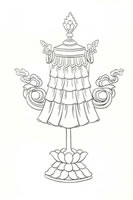Difference between revisions of "The Victory Banner"
(Created page with "thumb|250px| In Sanskrit, the banner or sign of victory is known as the dhvaja, meaning standard, flag or sign. Originally, the victory banner was a...") |
|||
| (3 intermediate revisions by 2 users not shown) | |||
| Line 1: | Line 1: | ||
[[File:victorybanner.jpg|thumb|250px|]] | [[File:victorybanner.jpg|thumb|250px|]] | ||
| − | |||
| − | |||
| − | |||
| − | |||
| − | |||
| − | |||
| − | |||
| − | |||
| − | Cylindrical victory banners made of beaten copper are traditionally placed at the four corners of monastery and temple roofs. These signify the Buddha's victorious dharma radiating to the four directions and also his triumph over the four Maras mentioned above. | + | In [[Sanskrit]], the [[banner]] or sign of {{Wiki|victory}} is known as the [[dhvaja]], meaning standard, [[flag]] or sign. Originally, the [[victory banner]] was a {{Wiki|military}} {{Wiki|standard}} carried in {{Wiki|ancient Indian}} warfare, and bore the specific insignia of its champion. For example in the {{Wiki|Mahabharata}}, {{Wiki|Krishna}}'s {{Wiki|chariot}} was adorned with a [[banner]] showing the image of the monkey-god {{Wiki|Hanuman}}. |
| + | |||
| + | The [[victory banner]] was adopted by early [[Buddhism]] as an {{Wiki|emblem}} of the [[Buddha]]'s [[enlightenment]], heralding the {{Wiki|triumph}} of [[knowledge]] over [[ignorance]]. It is said to have been placed on the {{Wiki|summit}} of [[Mt. Meru]] by [[Buddha]] himself, [[symbolizing]] his {{Wiki|victory}} over the entire [[universe]]. Again, [[Mount Meru]] here is believed to be the central {{Wiki|axis}} supporting the [[world]]. | ||
| + | |||
| + | The [[flag of victory]] also denotes [[Buddha]]'s {{Wiki|triumph}} over [[Mara]], who {{Wiki|personifies}} [[hindrances]] on the [[path]] to [[spiritual]] [[realization]]. Specifically, there are said to be four types of [[Maras]], each one representing an {{Wiki|individual}} hurdle on the [[path]] to [[spiritual]] progress. These are: | ||
| + | |||
| + | # The [[Mara]] of [[Emotional Defilement]] | ||
| + | # [[Mara]] of [[Passion]] | ||
| + | # [[Mara]] of the {{Wiki|Fear}} of [[Death]] | ||
| + | # [[Mara]] of {{Wiki|Pride}} and [[Lust]] | ||
| + | |||
| + | It was only after conquering these four negative traits that [[Buddha]] could proclaim {{Wiki|victory}} over [[ignorance]], and achieve [[nirvana]]. | ||
| + | |||
| + | Cylindrical [[victory banners]] made of beaten {{Wiki|copper}} are [[traditionally]] placed at the four corners of [[monastery]] and [[temple]] roofs. These signify the [[Buddha]]'s {{Wiki|victorious}} [[dharma]] radiating to the {{Wiki|four directions}} and also his {{Wiki|triumph}} over the four [[Maras]] mentioned above. | ||
{{R}} | {{R}} | ||
Latest revision as of 09:25, 8 February 2017
In Sanskrit, the banner or sign of victory is known as the dhvaja, meaning standard, flag or sign. Originally, the victory banner was a military standard carried in ancient Indian warfare, and bore the specific insignia of its champion. For example in the Mahabharata, Krishna's chariot was adorned with a banner showing the image of the monkey-god Hanuman.
The victory banner was adopted by early Buddhism as an emblem of the Buddha's enlightenment, heralding the triumph of knowledge over ignorance. It is said to have been placed on the summit of Mt. Meru by Buddha himself, symbolizing his victory over the entire universe. Again, Mount Meru here is believed to be the central axis supporting the world.
The flag of victory also denotes Buddha's triumph over Mara, who personifies hindrances on the path to spiritual realization. Specifically, there are said to be four types of Maras, each one representing an individual hurdle on the path to spiritual progress. These are:
It was only after conquering these four negative traits that Buddha could proclaim victory over ignorance, and achieve nirvana.
Cylindrical victory banners made of beaten copper are traditionally placed at the four corners of monastery and temple roofs. These signify the Buddha's victorious dharma radiating to the four directions and also his triumph over the four Maras mentioned above.
